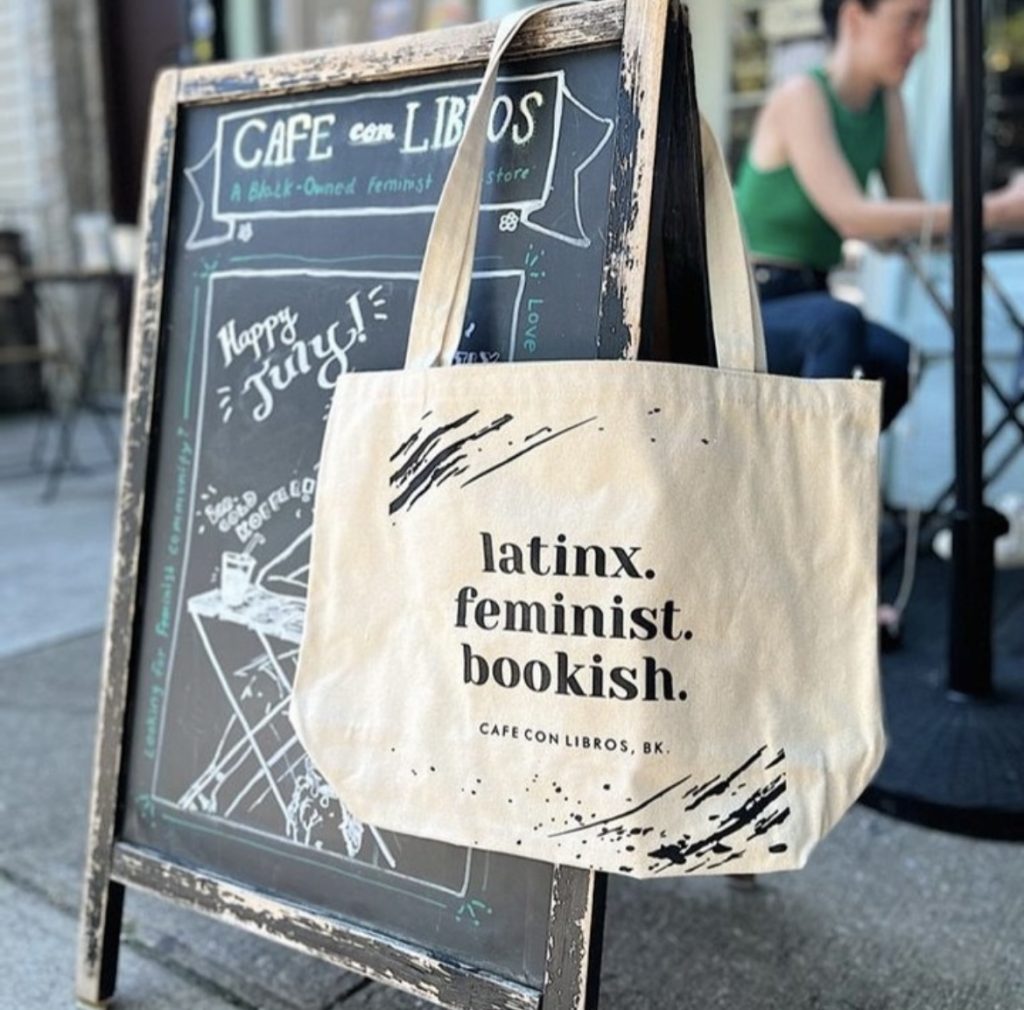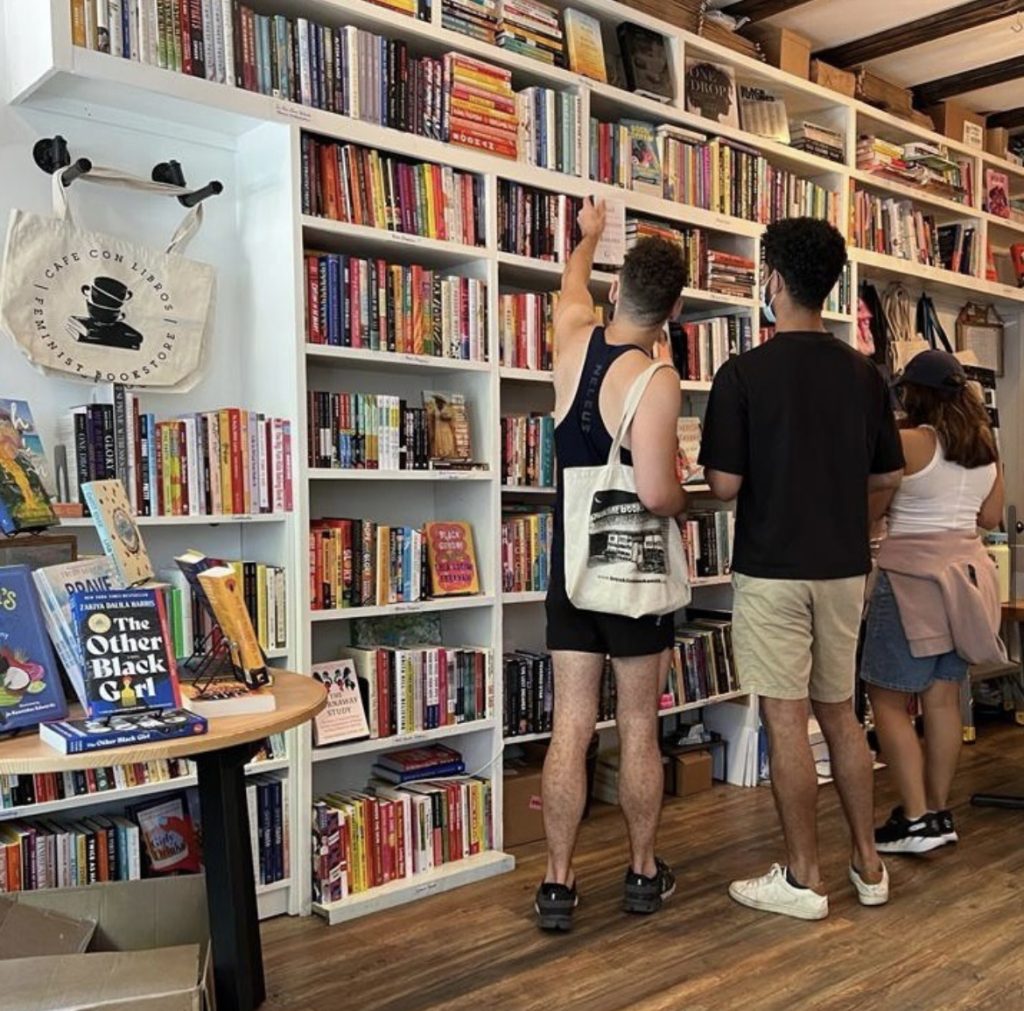Café con Libros: Proving That Maybe Bigger Isn’t Always Better
Down a quiet street nestled in the heart of Crown Heights, Brooklyn, lies Café Con Libros, a neighborhood staple and community center. The light blue paint of the exterior invites you in, and the ivy gently overhanging the sign reading “Black, Feminist & Bookish” adds a whimsical element that immediately charms you. Small tables are located outside, waiting for people to grab a steaming cup of coffee and sit down with a book.
On the left, featured books line the large window, enticing customers with their bright colors and intriguing titles. Such titles include My Broken Language: A Memoir by Quiara Alegría Hudes, which tells the story of Alegría Hudes growing up in Philly amongst her Puerto Rican family, fighting to become an artist; Las Madres by Esmeralda Santiago, which follows the life of women who journey from Puerto Rico to the Bronx, and explores themes such as gender, faith, and race; and cookbooks like Bountiful Cooking by Agatha Achindu, who explores her Cameroonian heritage and relationship to food.
Floor plan of Café con Libros, explaining significant choices in shelving and layout.
The window on the right boasts a collection of children’s books, including titles such as La Guitarrista by Lucky Diaz, illustrated by Micah Player, and Los coquíes aún cantan by Karina Nichole González, illustrated by Krystal Quiles. A pride flag and the flag of Panama, where owner Kalima DeSuze hails from, are proudly displayed in the window.
The window displays reflect the values Café con Libros stands for. A diverse array of authors and subject matter, reaching not only adults but also children. Books written in Spanish as well as English reiterates this mission of diversity and reflects the rich area of New York in which the store is located. The flag of Panama displays DeSuze’s pride for her heritage, and the pride flag ensures that all guests should feel welcome, that Café con Libros is a safe space for them.
Inside the store, welcoming faces greet you as you walk in facing the coffee bar, conveniently also where the register is located. The aroma of coffee grounds and sweet syrups fill the air, mixed with the delightful sounds of pages flipping as customers peruse books, and the milk steamer whistling into the air.
When inside, you are shocked by the small space. Nothing more than a square, it can at times feel claustrophobic when more than three people occupy the space. However, big windows that let in natural light, high ceilings, warm lighting, and bright white bookshelves create an illusion of space that does not exist. Lyndsie Manusos points out that the ways in bookstores are lit has become an increasingly important part of bookstore design. Based on this fact, Café con Libros has certainly paid special attention to the “vibe” in their store. The natural lighting not only creates space, but also an inviting place for folks to browse books while sipping a coffee. This reflects Café con Libros’ mission of being a community space where people would want to stop by and hang out.

Because of the smallness, books line the walls and sit on two circular tables by the door. Tote bags hang on an exposed brick column, highlighting the bookstore’s mission, stating things such as: “Black, Feminist & Bookish.” “Café con Libros, Feminist Bookstore.” “latinx. feminist. bookish.”
A tote bag sold by Café con Libros.
While short on space, Café con Libros fills the space with more than enough titles to explore for hours. Only having one main, floor to ceiling, bookshelf for their titles means that sections don’t exist as we are used to in other bookstores. Instead, the shelves are divided into cubes, and each cube is labeled with a “section” or theme. Such sections include poetry, black feminist classics, black American classics, Latinx diaspora, African diaspora, Caribbean diaspora, LGBTQ+, romance, and more. Within each section, fiction and non-fiction, speculative and realist, romance and mystery, can all be mixed together. The shelving of the books often reflects, not the genre of the book necessarily, but the identity of the author or content. Lydia Pyne, in her book Bookshelf, says that “[b]ookshelves do more than catalog books; bookshelves put those books on display” (22). Further, “what books are put where on which shelves reflects the values…that shape the shelves and books” (22). Café con Libros demonstrates their values by the way in which they categorize books. They demonstrate that their mission of uplifting feminist, black, latinx, and other underrepresented voices is what defines their categorization more than other, more typical, ways.
These small cube sections, and the condensed space of the store, create a difficulty for Café con Libros. The difficulty is that of selection. Most sections have 20 or less titles, and of those normally only one or two of the books has extra copies. The extra copies are stocked at the back of the shelf, lying horizontally behind the otherwise normally shelved books (vertical, with the spine faced out). Such books that are lucky enough to have extra copies stocked are best sellers for the store, such as All About Love by bell hooks, The Color Purple by Alice Walker, and The Bluest Eye by Toni Morrison.
More books are housed on round tables adjacent to the door. On the left is a collection of adult books, both fiction and non-fiction that are new or highlighted by the staff. Opposite this table on the right side of the store is another round table that features children’s books in a similar way. The remaining collection of children’s books is featured on a smaller set of the cubic shelving found on the left.
While visiting with my friend, Sophie, she commented that many of these titles were not ones that she had heard of before. In this alone, it is clear that Café con Libros has done their job and done it well. They have created a space in which smaller authors are able to have their work displayed, work that focuses on their experiences as women, people of color, and more, in a place that ardently cares about these missions. Café con Libros is not one to fall victim to so-called “rainbow capitalism,” as many stores do around Pride Month or Black History Month, but practices what they preach. They uplift as many stories as they can that center on issues that they care about, stories that are impactful, not only for people who share those identities, but also for the general population to educate themselves.

A picture posted by Café con Libros on Instagram, captioned with this quote by Jen Campbell: “You see, bookstores are dreams built of wood and paper. They are time travel and escape and knowledge and power. They are, simply put, the best of places.“
Lyndsie Manusos, in her article “The Science and Recent History of Bookstore Design,” notes that chain stores are beginning to move to doing what “independents do best and have always been doing: Catering to their customers’ interests and the needs and values of the surrounding community.” The mission of owner Kalima DeSuze has always been to do just that, and not only cater to the needs and interests of her community, but to create new interests by showcasing a unique and diverse display of titles.
Being able to browse a store that was so warm and welcoming (and had some of the best coffee I’ve ever tasted), was a privilege. Seeing the care that the staff take to display and shelve their books to align with their mission stuck out to me as something that I had not seen in many other stores. Often, indies have a theme or mission, but rarely do they stick to it as well as Café con Libros. Their community centered focus shines through, as when you walk into the store, you are at the center of it. The books are off to the side, but the people who gather and chat and browse are the center of Café con Libros’ world.
Sources
Manusos, Lyndsie. “The Science and Recent History of Bookstore Design.” Book Riot, 23 February 2022. https://bookriot.com/the-science-and-recent-history-of-bookstore-design/. Accessed 31 October 2023.
Pyne, Lydia. Bookshelf. New York, Bloomsbury Academic, 28 January 2016.
Media
Floor Plan made by Janelle Cass using www.thinglink.com.
Instagram Reel by @lavidaseguncata
Images by @cafeconlibros_bk on Instagram
Other images by Kelsey F., Kassidy K., and Café con Libros on Yelp. https://www.yelp.com/biz/cafe-con-libros-brooklyn-2.

0 Comments